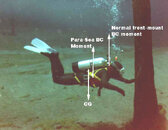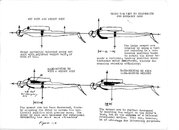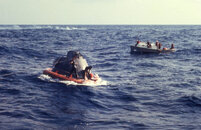A couple of years ago I put together a presentation for the Northwest History of Diving Association meeting, and presented it. I still have it, and have converted it to PDF format and attached it here. Amongst these slides is this diagram where I show the different moment arms for different BCDs, and how they can influence our attitude in the water. This diagram was presented at IQ 6, the Sixth International Conference on Underwater Education in 1974 for a paper I wrote titled "Comments on Buoyancy Control and Emergency Procedures." I had a companion paper in that publication titled "The Life Vest," where I detailed how an unconscious diver in a life vest would be supported; basically there were two different positions, one with the face in the water and one with the head supported out of the water. I named them "Stable One," with the head out, and "Stable Two" with the head down. A lot depended upon how the diver reached the surface, face up or down.
The "Stable" positions were named after these two positions for the Apollo space capsule when it hit the water, whereby Stable One was in the normal position, while Stable Two was upside down. Ever wonder about those three inflated balloons on the top of the Apollo capsule; those were to flip the capsule over if it ended up in Stable Two position. The photo below is of a boiler plate Apollo capsule, where we (USAF Pararescue) placed the floatation collar on it. Because it is a boiler plate (markup) capsule, no balloons are on the top.
SeaRat







